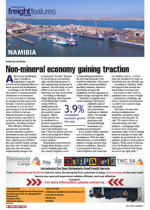The Port of Walvis Bay has experienced remarkable growth in recent years with significant increases in volumes across bulk, breakbulk and containerised cargo, driving a push for expanded infrastructure to meet rising demand.“Growth at the Port of Walvis Bay has been exponential, and the best is yet to come,” says Elias Mwenyo, Namport’s executive for commercial services. “Exciting developments are under way at the port. We have begun handling commodities that were previously not moved through here. Volumes of copper, zinc and nickel are on the rise, along with sulphur and fertiliser, a commodity we began handling only last year. Given this growth, we have no choice but to expand our infrastructure to not only accommodate current volumes but also meet the future demand we’re anticipating.”According to Mwenyo, the strategy has always been to invest ahead of demand. “There are two key drivers in the port business: costs on one side and revenue on the other. Our approach is to consistently reduce the cost of doing business, ensuring we have sufficient returns to reinvest in infrastructure. As a state-owned enterprise (SOE), moving quickly can be challenging due to often cumbersome procedures, especially when it comes to infrastructure investments. That’s why our strategy focuses on actively engaging the private sector to contribute to the development of the port, ensuring we stay ahead of demand and continue to grow.”The concession agreement signed in October last year with Terminal Investment Limited (TiL), a subsidiary of MSC, to take over the container handling operations at the Port of Walvis Bay, is an example of the type of collaboration Namport is actively pursuing. “We’ve always cited a throughput capacity of 750 000 TEUs, but with TiL on board, they are working to configure the terminal for even greater capacity, aiming to surpass that figure,” Mwenyo told Freight News, indicating that more private-sector investment and involvement in port infrastructure could be expected.In and around the Port of Walvis Bay, it is a hive of activity as infrastructure development gains momentum. During a port tour, Freight News saw the construction of a massive new salt warehouse, alongside several other facilities being built by leading logistics service providers. These developments, said Mwenyo, all ref lected the port’s rapid growth and its strategic push to expand capacity and accommodate rising cargo volumes.He is adamant, however, that Namport will not enter into public-private partnerships simply for the sake of appearances. “We have appointed a consultant to conduct a comprehensive review of our entire business model to ensure that every agreement we sign is fit for purpose and aligned with our strategic objectives.“We’ve made incremental but consistent progress. Our approach has always been to avoid rushing. Instead, we focus on being deliberate and steady, ensuring that every step we take is aligned with our long-term vision. As we gradually expand our infrastructure, the rapid growth we’re experiencing is a good challenge to have, but it also demands a coordinated response. We can only manage it effectively if all players in the supply chain work closely together.” LV

